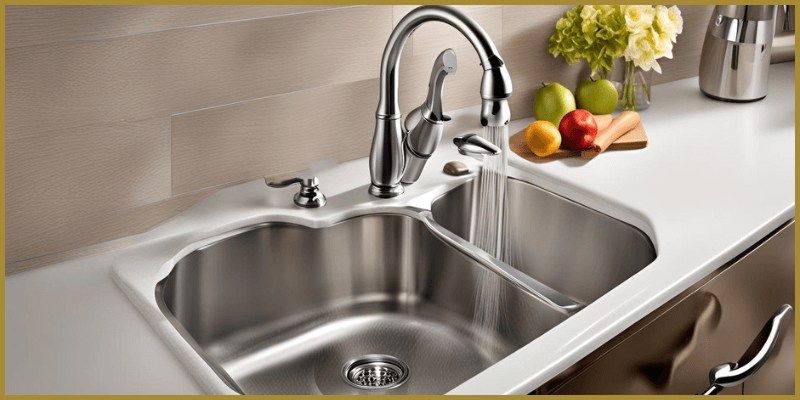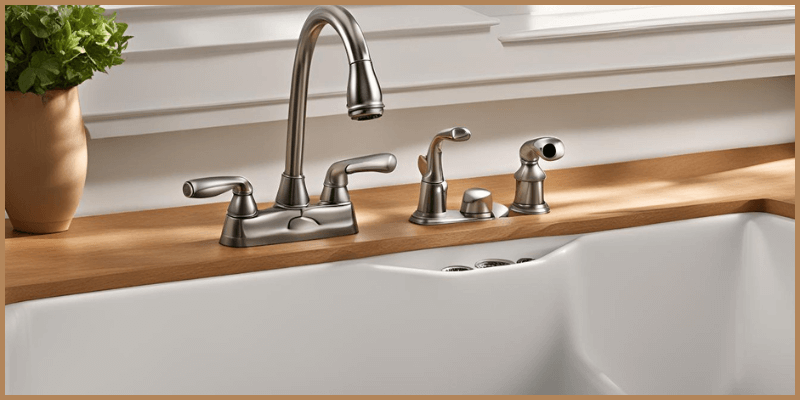How to Tighten Moen Kitchen Faucet Base
A loose fitting culinary space faucet platform can be a source of frustration, leading to unsafe operations and potentially causing water leakage under the decline. This common issue might not seem urgent initially, but if ignored, it can lead to more significant problems, including damage to your kitchen cabinets and flooring. It’s a disturbance that interferes with daily kitchen activities, from cleaning to cooking and detracts from your cooking area space’s overall functionality and aesthetic.
Fortunately, the issue of a loose water outlet base does not always necessitate a call to the plumber. With the right tools and some know-how, tightening a valve scullery spout footing is a manageable DIY task that can save time and money. This process will secure the faucet, prevent potential water damage, and preserve the integrity of your culinary space fixtures.
In the following sections, we’ll guide you through a step-by-step approach to address this issue. From identifying the tools required to complete the task efficiently to providing detailed, easy-to-follow instructions, this article aims to empower you to tackle the problem head-on. By the end, you’ll have all the knowledge needed to fix a loose spigot cookery valve stand yourself, ensuring it remains tight and functional for years to come.

How to Tighten Moen Kitchen Faucet Base? 9 Steps
If you follow the exact one given below by an expert, you’ll get a ride on your How to stiffen tap galley spigot support issue.
Step: 1 Clear the Sink Area
Begin by removing any items from under the lower to ensure you have ample space and visibility. It’s essential to have easy access to the stand of the ap.
Step: 2 Shut Off the Water Supply
Locate the valves under the dip that control your faucet’s hot and cold water supply. Turn these valves clockwise to shut off the water. This step is crucial to prevent any accidental water flow while working.
Step: 3 Gather Your Tools
You will need an adjustable wrench, a flashlight, and a reservoir ratchet. A pan wrench is designed to work in tight spaces under the submerge.
Step: 4 Identify the Nut
Use the flashlight to look under the descendand identify the mounting nut holding the water outlet. The location and size of the nut can vary, so take a moment to inspect the support of your faucet.
Step: 5 Adjust the wrench Correctly
Adjust your Wrench to fit the size of the nut snugly. If you’re using a receptacle spanner, make sure it’s set to strengthen.
Step: 5 Tighten the Nut
With your socket wrench, turn the nut clockwise. Do so gently at first to avoid damaging any components. Secure the nut until snug, but do not over clamp it, as this can damage the threads or spout.
Step: 6 Check for movement
After tightening, check the valve from above to see if there’s any movement by gently trying to wobble it. There should be no movement if the foundation is tightened correctly.
Step: 7 Turn On the Water Supply
Turn the water supply valves back on once everything feels secure by turning them counterclockwise. Check for any discharge around the platform of the spigot.
Step: 8 Test the Faucet
Turn on the ap to test hot and cold water. Ensure there are no exude and the faucet handle moves smoothly without wobbling.
Step: 9 Clean Up
With your secure water outlet, replace any items you may have removed from under the decline and clean up your work area. Congratulations, you’ve successfully tightened your tap cooking area spout stand.
Following these steps, you can effectively tighten a loose installation scullery ap support, ensuring its stability and function without professional intervention.
How to Secure a Moen cooking area Faucet Base in 10 Steps

Step: 1 Introduction
Tightening a loose valve scullery water outlet base is a common DIY fix that homeowners might face, and executing this task requires attention to detail and patience.
While taking on plumbing repairs might seem daunting to some, solving home maintenance issues without needing to call in a professional can be gratifying.
This guide is tailored to provide clear, step-by-step instructions that simplify the process, making it accessible even to those who may not be traditionally handy.
By following the outlined steps, you will restore the full functionality of your culinary space spout and gain a sense of achievement and confidence in your ability to tackle similar issues in the future.
Remember, a well-maintained home is vital to comfortable living, and taking charge of minor repairs is crucial for home upkeep.
Step: 2 Gather Necessary Tools
Having the right tools on hand before tightening your spigot galley valve foundation is vital.
You won’t need an extensive toolkit, but a few specific items will make the job easier and more efficient. Ensure you have an adjustable ratchet, which is versatile and can adjust to various hardware sizes.
A bowl torque wrench is also highly recommended; its long handle and swiveling head make it ideal for reaching nuts in tight spaces under the lower.
A flashlight or headlamp will provide visibility in the dimly lit area under the dip. A small container or a cloth can be handy to catch any water drips that might escape while working on the plumbing.
By gathering these tools in advance, you’ll be prepared to proceed confidently, minimizing delays and frustrations during the repair.
Step: 3 Turn Off the Water Supply
Ensuring the water supply is fully turned off before commencing any work on your tap galley spigot is critical.
This step is paramount for preventing unexpected water flow that might complicate the task or create a mess under your submerge. Locate the water supply valves beneath your descend; these are usually chrome or plastic valves connected to flexible supply lines that run up to your ap.
Turn these valves clockwise until they are firmly closed. If the valves are hard to turn or haven’t been used in a while, proceed cautiously to avoid damaging them.
Once you have shut off the water supply, turn on the faucet to release any remaining water pressure in the lines, ensuring a dry workspace for the task ahead.
Remember, taking this precautionary step facilitates a smoother repair process and underscores the importance of safety and preparedness in DIY home maintenance tasks.
Step: 4 Identify Loose Components
Before proceeding with the tightening process, it is essential to accurately identify which components of your apparatus culinary space faucet are loose.
Start by examining the faucet handle, the platform of the faucet, and where the faucet body meets the sink or countertop. Sometimes, the issue may not be with the base but with a different part of the faucet assembly.
Gently wiggle different parts of the faucet to determine where the looseness occurs. This step is crucial, ensuring you address the correct problem area, prevent unnecessary adjustments, and provide a focused and effective repair.
Identifying the precise cause of the instability will guide you in applying the correct tightening technique, leading to a more secure and functional faucet.

Step: 5 Access Underneath the Sink
Access to the space underfoot your scullery sink is critical in tightening your component cooking area faucet footing.
This area, often cramped and cluttered with cleaning supplies or waste bins, requires preparation to become a workable space. Begin by removing any items under the sink to create sufficient room for maneuvering.
This not only facilitates more accessible access to the faucet’s underside but also protects your belongings from getting wet or damaged.
If your sink cabinet has a baseliner, consider placing a towel or a small receptacle at the bottom of the work area to catch any residual water drips that may escape the pipes.
Ensuring good lighting is also vital; a portable lamp or a headlamp can significantly improve visibility, making the task simpler and safer.
Clearing and preparing the area for work is an essential step that sets the stage for a smooth repair process.
Step: 6 Tighten Mounting Nuts or Screws
After clearing the area below the sink and identifying the loose components, the next step involves addressing the heart of the issue – the mounting nuts or screws that secure the faucet stand to the countertop.
Begin by locating these crucial fasteners; they typically reside directly under the sink, attaching the faucet to the countertop. Using the pan spanner, adjust its head to fit the size of the fixing or secure you’re working on.
A firm grip and gentle turns are key — over-tightening could damage the threads or the faucet. If you’re dealing with screws, an adjustable adjustable wrench or a suitable screw driver might be more appropriate.
Ensure each fastener is snug but not overly tight, checking the stability of the faucet support as you progress. This precise adjustment will significantly contribute to the faucet’s overall strength, mitigating any wobble and preventing future loosening.
Step: 7 Check for Leaks
Once the faucet supporthas been securely tightened, conducting a thorough inspection for potential discharge is crucial. Reopen the water supply valves beneath your sink by turning them counterclockwise, and observe the faucet for a few minutes as the water flows.
Pay particular attention to the foundation of the faucet and the connections under the sink where you’ve worked. It is not uncommon for minor adjustments or disturbances in the plumbing to initiate ooze.
Should you notice any water escaping, promptly turn off the water supply and review your tightening work, ensuring all connections are adequately secured.
This step is not only for maintaining the integrity of your repair but also helps conserve water and prevent water damage under the sink. Remember, detecting and addressing these issues early can save time and resources in the long run.
Step: 8 Test Faucet Operation
After ensuring everything is tightened correctly and there are no seep, the final step in securing your spigot galley faucet is to test its operation.
With the water supply back on, operate the faucet in hot and cold settings. Check for ease of movement in the faucet handle and ensure the water flow is consistent and stable.
Pay attention to any unusual sounds or fluctuations in water pressure, as these might require further adjustments.
Testing verifies the effectiveness of your repairs and reassures that the faucet will function smoothly during everyday use.
This step underscores the importance of thoroughness in DIY projects, ensuring that your efforts result in lasting improvements.
Step: 9 Maintenance Tips
Regular maintenance is critical to extending the life of your tap cookery faucet and ensuring its continuous optimal performance.
Simple yet effective practices can prevent common issues such as drip, loose components, and build-up of minerals. Firstly, it’s advisable to periodically inspect your faucet for any signs of wear or leakage, especially around the platform and the handle.
Using a gentle cleanser and soft cloth, clean the faucet’s exterior to prevent mineral build-up from hard water, which can impede water flow and affect the faucet’s finish.
Also, lubricating the moving parts of the faucet annually with silicone-based lubricant can maintain smooth operation and prevent stiffness.
Avoid using harsh chemicals or abrasive materials that could damage the finish. By incorporating these maintenance tips into your routine, you can enhance the longevity and functionality of your fixture culinary space faucet.
Step: 10 Conclusion
In conclusion, the process of tightening a valve scullery faucet footing, though it may appear daunting at first, can be efficiently managed with patience, the right tools, and a systematic approach.
From initial diagnosis to the final checks, each step is crucial in ensuring a secure and fully functional faucet.
This addresses the immediate issue of a loose stand and contributes to the longevity and reliability of your kitchen’s most frequently used fixture.
Additionally, incorporating routine maintenance into your schedule can prevent future issues, save time, and avoid potential water damage.
With this knowledge and a proactive attitude, you can ensure that your tap cookery faucet remains a dependable part of your galley for years.
Conclusion
Having successfully tightened the spigot culinary space faucet support, patience, and precise attention to detail were pivotal in accomplishing this task.
It was essential to methodically follow each step, from preparing the work area under the sink to meticulously tightening every bolt and twist, ensuring there were no leaks, and ultimately, testing the faucet’s operation.
My adherence to regular maintenance practices will undeniably extend the life of the faucet, preventing common issues and maintaining its optimal performance.
This DIY project has empowered me with valuable knowledge and skills, reinforcing the importance of proactive home maintenance measures.
Armed with this experience, I am more prepared to tackle similar challenges in the future, maintaining the reliability and functionality of my home’s fixtures.
FAQs
How do you tighten a loose cookery faucet base?
To tighten a loose scullery faucet base, use a basin socket wrench or an adjustable wrench to fasten the twist below the sink securely.
How do you tighten a faucet stem?
To tighten a faucet stem, turn off the water supply, remove the handle, and use a ratchet to tighten the packing fastener or replace it if worn out.
Why is my faucet loose?
A faucet may become loose due to wear and tear, improper installation, or deterioration of its internal components.
Is there a tool to tighten the cooking area faucet?
A basin torque wrench is the specialized tool commonly used to tighten nuts on galley faucets.







